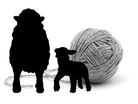The Perfect Nest
Young cat, if you keep your eyes open enough, oh, the stuff you would learn! The most wonderful stuff!
—DR. SEUSS
After years of draining my writing energy, the farm slowly begins to give back, with Hit by a Farm, and then The Compassionate Carnivore, a mix of memoir, nonfiction, and self-help. Yet the farm continued to withhold ideas for children’s stories. Farms should be ripe with children’s story ideas because farms play such a role in their learning. Stephen Kellert, who studies animals and human behavior, found that more than 90 percent of the characters used to teach language and counting to young children are animals.
Yet I manage to go years without any decent ideas. But then the Farm Story Goddess looks down upon our meager fifty acres, where I sit dejectedly without inspiration, and graciously awards me two events that will generate a story.
The first event is the day in the barn when I hear something banging back in the corner behind a feed barrel. I timidly peer down into the darkness, afraid to see a rat. Instead, I see what looks like a chicken’s body and a duck’s head. Whoa. Gotta lay off the caffeine. I ignore my hallucination and continue with chores.
The next morning I hear the same banging, only this time when I look, I see what appears to be a duck’s body with a chicken’s head. Now I am worried, so I track down Melissa, who’s out in the pasture fixing a fence. She knows exactly what I’m talking about. “A duck and chicken both laid an egg back there and neither wants to give up the nest.” Later I find five hens in a nest box meant for one, basically stacked on top one another, each determined to lay her egg in that nest.
The second event is of a feline nature. We don’t encourage stray cats to live in our barns or pastures because kittens can carry a disease that causes abortions in sheep. Not good. But when a half-grown orange-and-white cat shows up, so friendly he must have been dumped (by one of those irresponsible pet owners who should be abandoned in the middle of the Arctic Circle as punishment for doing this to a domestic pet), we fall in love and name him Oliver. He takes up residence in the hay mow, the warmest, driest, safest place on the farm.
The next year, Oliver himself adopts a half-grown cat, but the only thing we ever see of this guy is the flash of his orange tail as he runs from us. All winter long we feed two cats, one of which is terrified of us. But then Melissa begins leaving a saucer of milk in the barn. Within a few days the orange cat comes down the wooden ladder, sniffs the milk on Melissa’s hands, and rolls over on his back as if to say he’ll do anything for some milk.
Two cats—Oliver and Pumpkin—and many baby chicks and ducklings hatching every year would seem to be a bad combination. But Melissa scolds the cats whenever they look at the babies, and soon the boys figure out that if they’re going to be allowed to stay, baby poultry are off limits. When Mama Duck has a batch of eighteen ducklings, she marches them past Oliver, stretched out on the barn floor. He watches, but he doesn’t dare touch.
I begin to think—what if I write a story about a cat that wants to eat the eggs in a nest but instead ends up taking care of the babies that hatch from those eggs? And maybe there would be poultry that fight over the same nest. The result is The Perfect Nest.
For me, waiting for a picture book to make its way from a few scribbled notes in my notebook, to a typed manuscript given to the illustrator, to a series of sketches, to many finished paintings feels like a century, but when illustrator John Manders is finished, the story becomes a real book.
Here’s the publisher’s description: “Jack the cat is building the perfect nest. It’s bound to attract the perfect chicken, who will lay the perfect egg, which will make the perfect omelet. And sure enough, a chicken shows up (‘¡Caramba!’) but so do a duck (‘Sacré bleu!’) and a goose (‘Great balls of fire!’). Feathers get ruffled—and Jack gets much more than breakfast—in a funny tale rich in details with a sweet final twist.”
After the book is published, I begin hearing fun stories from teachers who read the book to their class, then the next day all the first-graders run around the classroom exclaiming, “¡Caramba! Sacré bleu! Great balls of fire!”
Our dear Oliver died a few years later, and we were heartbroken. We adopted little Maisie and Eddie Velvet. Unfortunately, Eddie was a roamer, and after we’d totally fallen for him, one day a year later he never returned home. Pumpkin and Maisie remain, and Maisie has learned the same lesson about baby poultry as Oliver and Pumpkin did. Paws off. She knows sparrows and mice are fair game, however, so she stalks them daily.
Because she loves us, and is a good provider, Maisie often shares her kill, leaving the only part of the mouse she doesn’t eat on our front step. I’ve yet to come up with an idea for a children’s book about these green, kidney-bean-sized large intestines, but perhaps one day my muse will return.

